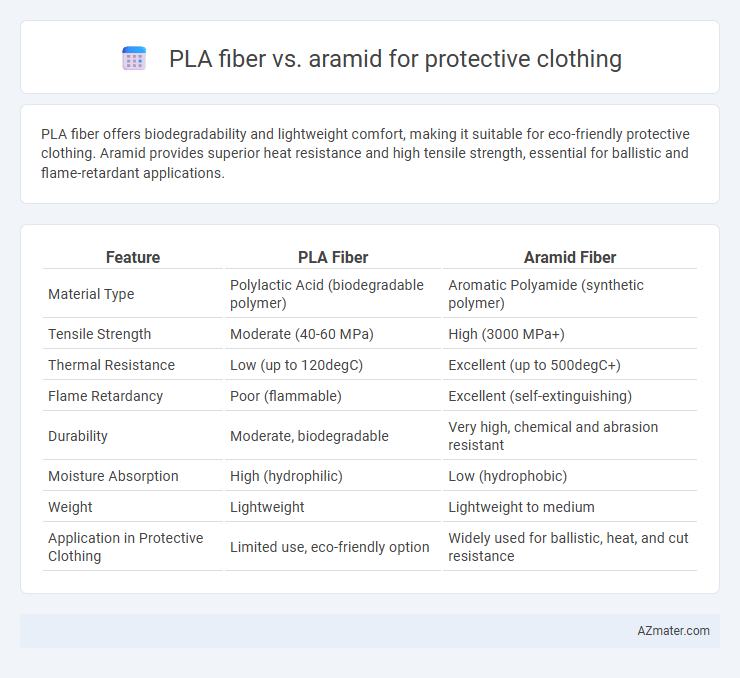PLA fiber offers biodegradability and lightweight comfort, making it suitable for eco-friendly protective clothing. Aramid provides superior heat resistance and high tensile strength, essential for ballistic and flame-retardant applications.
Table of Comparison
| Feature | PLA Fiber | Aramid Fiber |
|---|---|---|
| Material Type | Polylactic Acid (biodegradable polymer) | Aromatic Polyamide (synthetic polymer) |
| Tensile Strength | Moderate (40-60 MPa) | High (3000 MPa+) |
| Thermal Resistance | Low (up to 120degC) | Excellent (up to 500degC+) |
| Flame Retardancy | Poor (flammable) | Excellent (self-extinguishing) |
| Durability | Moderate, biodegradable | Very high, chemical and abrasion resistant |
| Moisture Absorption | High (hydrophilic) | Low (hydrophobic) |
| Weight | Lightweight | Lightweight to medium |
| Application in Protective Clothing | Limited use, eco-friendly option | Widely used for ballistic, heat, and cut resistance |
Introduction to Protective Clothing Materials
Protective clothing materials such as PLA fiber and aramid play critical roles in personal safety across various industries. PLA fiber offers biodegradability and comfort with moderate strength, making it suitable for environmentally conscious applications. Aramid fibers, renowned for their exceptional heat resistance and high tensile strength, provide superior protection against mechanical and thermal hazards in demanding environments.
Overview of PLA Fiber for Protective Applications
PLA fiber, derived from renewable resources such as corn starch, offers lightweight and biodegradable properties ideal for protective clothing, combining eco-friendliness with comfort. It exhibits high moisture-wicking capabilities and good thermal insulation, making it suitable for applications requiring breathability and temperature regulation. While not as inherently flame-resistant as aramid fibers, PLA can be enhanced through treatments to improve durability and protective performance in various safety garments.
Key Characteristics of Aramid Fibers
Aramid fibers are renowned for their exceptional strength-to-weight ratio, high tensile strength, and excellent heat resistance, making them ideal for protective clothing applications where durability and thermal protection are critical. These fibers also exhibit outstanding chemical resistance and low flammability, enhancing their suitability for environments exposed to extreme conditions and potential hazards. Unlike PLA fibers, which offer biodegradability and moderate mechanical properties, aramid fibers provide superior impact resistance and structural integrity essential for ballistic and fire-resistant garments.
Comparative Strength and Durability
PLA fiber exhibits moderate tensile strength and biodegradability, making it less durable for prolonged protective clothing use compared to aramid fibers, which offer exceptional tensile strength and resistance to abrasion, heat, and chemicals. Aramid fibers like Kevlar deliver superior impact resistance and long-term durability, maintaining structural integrity under extreme conditions crucial for protective garments. The high-performance characteristics of aramid fibers make them the preferred choice in military, firefighting, and industrial safety applications where maximum durability and strength are required.
Heat and Flame Resistance: PLA vs Aramid
Aramid fibers exhibit superior heat and flame resistance compared to PLA fibers, making them ideal for protective clothing exposed to high temperatures. Aramid can withstand sustained temperatures above 400degC without melting or igniting, while PLA fibers degrade and melt at around 180degC. This thermal resilience enables aramid to provide enhanced protection against flames, heat, and thermal hazards in firefighting and industrial environments.
Comfort and Wearability Factors
PLA fiber offers superior breathability and moisture-wicking properties, making it ideal for comfort in protective clothing. Aramid fibers provide excellent heat resistance and durability but tend to be less flexible and heavier, potentially reducing wearability. Balancing PLA's lightweight softness with Aramid's protective strength enhances overall garment comfort and user mobility in demanding environments.
Environmental Impact and Sustainability
PLA fiber, derived from renewable resources like corn starch, offers significant environmental benefits with its biodegradability and lower carbon footprint compared to aramid fibers, which are petroleum-based and non-biodegradable. Aramid fibers, while providing superior heat and abrasion resistance crucial for protective clothing, involve energy-intensive production processes that contribute to higher greenhouse gas emissions. Sustainable protective clothing solutions increasingly favor PLA fibers for their reduced environmental impact, though ongoing innovations aim to improve the durability and protective qualities of bio-based materials to match aramid performance.
Cost Analysis: PLA Fiber vs Aramid
PLA fiber offers a cost advantage over aramid due to its bio-based sourcing and lower production expenses, making it an economical option for protective clothing. Aramid fibers, such as Kevlar, have higher raw material and manufacturing costs but provide superior heat resistance and durability. The cost-benefit analysis favors PLA for budget-sensitive applications, while aramid remains preferred for high-performance protective gear requiring extreme strength and thermal stability.
Application Case Studies in Industry
PLA fiber demonstrates promising application in protective clothing with enhanced biodegradability and moisture-wicking properties, making it suitable for lightweight industrial uniforms where comfort and environmental impact are critical. Aramid fibers, such as Kevlar and Twaron, dominate heavy-duty protective gear in firefighting, military, and law enforcement due to superior cut, heat, and abrasion resistance. Case studies reveal that combining PLA with aramid in composite fabrics optimizes both sustainability and durability, meeting stringent safety standards in high-risk industrial environments.
Future Trends in Protective Clothing Materials
PLA fiber offers biodegradable and sustainable alternatives in protective clothing, promoting eco-friendly solutions without compromising lightweight strength and breathability. Aramid fibers continue to dominate with exceptional fire resistance, high tensile strength, and thermal stability, crucial for industrial and military applications. Future trends emphasize hybrid composites combining PLA's sustainability with aramid's durability to enhance protection while reducing environmental impact.

Infographic: PLA fiber vs Aramid for Protective Clothing
 azmater.com
azmater.com